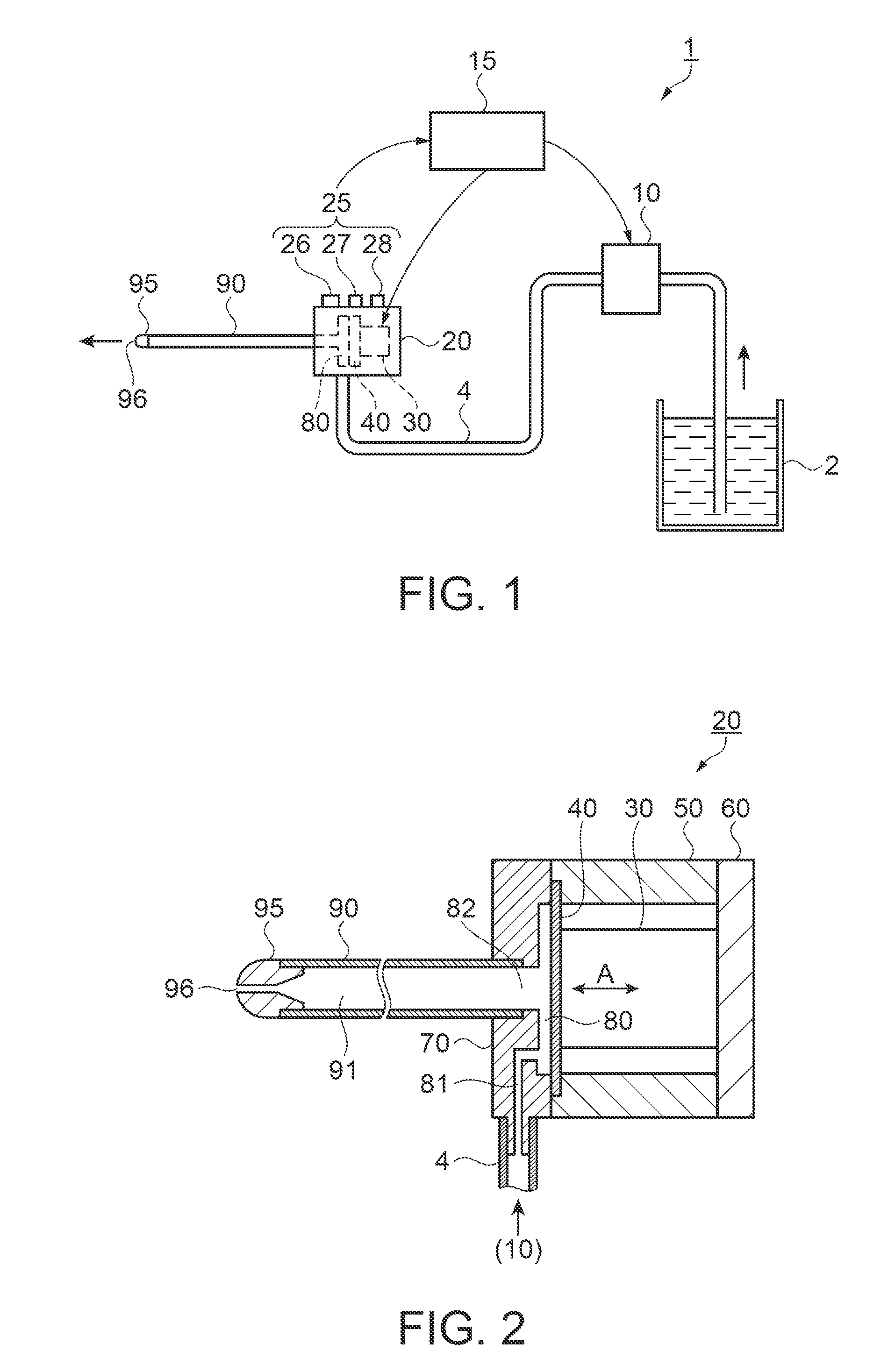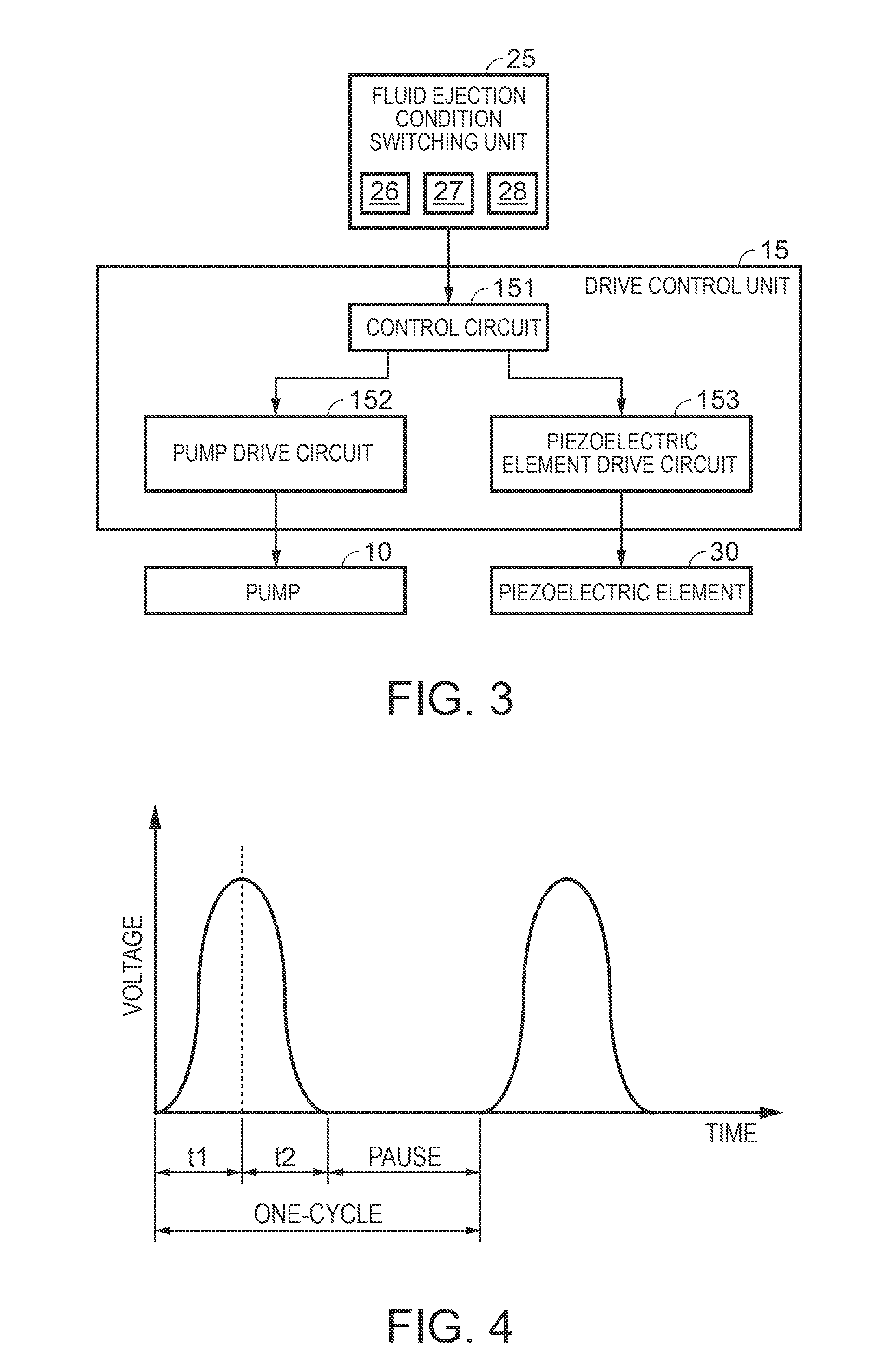Fluid ejection method and fluid ejection device
a technology of fluid ejection and fluid ejection, which is applied in the direction of fluid jet surgical cutters, medical science, surgery, etc., can solve the problems of weakened excision power per pulse, difficulty for users to select optimal fluid ejection, excess or deficiency, etc., and achieve the effect of increasing the flow rate of fluid ejection
- Summary
- Abstract
- Description
- Claims
- Application Information
AI Technical Summary
Benefits of technology
Problems solved by technology
Method used
Image
Examples
first embodiment
[0041]FIG. 1 is a configuration drawing showing the fluid ejection device as a surgical instrument. In FIG. 1, a fluid ejection device 1 includes a fluid supply container 2 in which fluid is stored, a pump 10 as a fluid supplying unit, a pulsed flow generator 20 as a pulsed flow generating unit configured to transform fluid supplied from the pump 10 into a pulsed flow, and a drive control unit 15 as a controller configured to control drive of the pump 10 and the pulsed flow generator 20. The pump 10 and the pulsed flow generator 20 are connected by a fluid supply tube 4.
[0042]A connecting flow channel tube 90 having a form of a thin pipe is connected to the pulsed flow generator 20. A nozzle 95 having a fluid ejection opening 96 with a reduced flow channel diameter is fixedly inserted to a distal end of the connecting flow channel tube 90.
[0043]The pulsed flow generator 20 includes a fluid ejection condition switching unit 25. The fluid ejection condition switching unit includes an ...
second embodiment
[0081]The fluid ejection method according to a second embodiment will be described. In the second embodiment, the fluid supply flow rate is varied in proportion to the displacement volume. In a description of the second embodiment, the same components as the first embodiment are designated by the same reference numerals and description thereof is omitted.
[0082]FIG. 9 is a graph schematically showing a drive waveform according to the second embodiment. FIG. 10 is a graph schematically plotting the fluid supply flow rate versus the displacement volume. The drive waveform illustrated in FIG. 9 is a rectangular wave. An increase of the frequency of the drive waveform is achieved by changing the length of the pause. Since the drive waveform is the rectangular wave, the through rate of the voltage rise does not change even though the gain of the drive voltage is changed. If the displacement volume per drive of the piezoelectric element is increased by increasing the gain of the drive volt...
third embodiment
[0091]The fluid ejection method according to a third embodiment will be described. In the third embodiment, the voltage rise time of the drive waveform of the piezoelectric element 30 with respect to the time during which the volume of the pressure chamber 80 is reduced is maintained substantially constant when varying the drive frequency. In a description of the third embodiment, the same components as the first embodiment are designated by the same reference numerals and description thereof is omitted.
[0092]A case where the repetition frequency is lowered when a drive waveform as that shown in FIG. 4 is employed as a basic drive waveform will be described. FIG. 12 is a graph schematically showing the drive waveform when a repetition frequency is lowered. In FIG. 12, the pause is elongated, and the voltage rise time t1 of the drive waveform of the piezoelectric element 30 is not changed with respect to the time during which the volume of the pressure chamber 80 is reduced. The thro...
PUM
 Login to View More
Login to View More Abstract
Description
Claims
Application Information
 Login to View More
Login to View More - R&D
- Intellectual Property
- Life Sciences
- Materials
- Tech Scout
- Unparalleled Data Quality
- Higher Quality Content
- 60% Fewer Hallucinations
Browse by: Latest US Patents, China's latest patents, Technical Efficacy Thesaurus, Application Domain, Technology Topic, Popular Technical Reports.
© 2025 PatSnap. All rights reserved.Legal|Privacy policy|Modern Slavery Act Transparency Statement|Sitemap|About US| Contact US: help@patsnap.com



